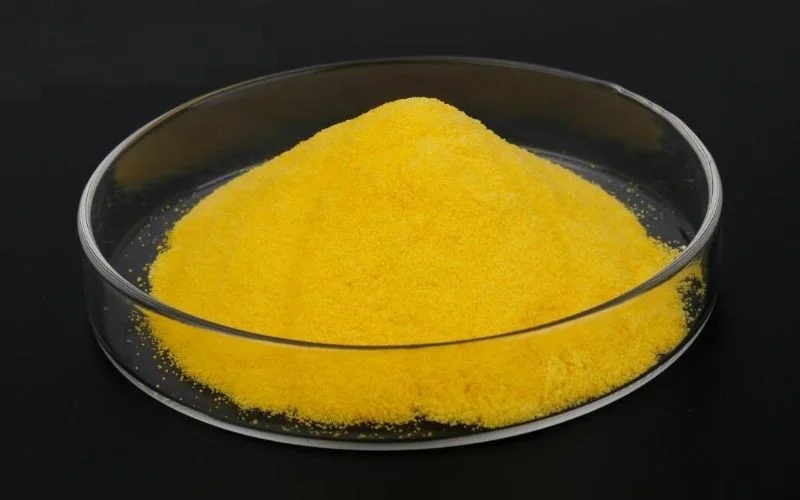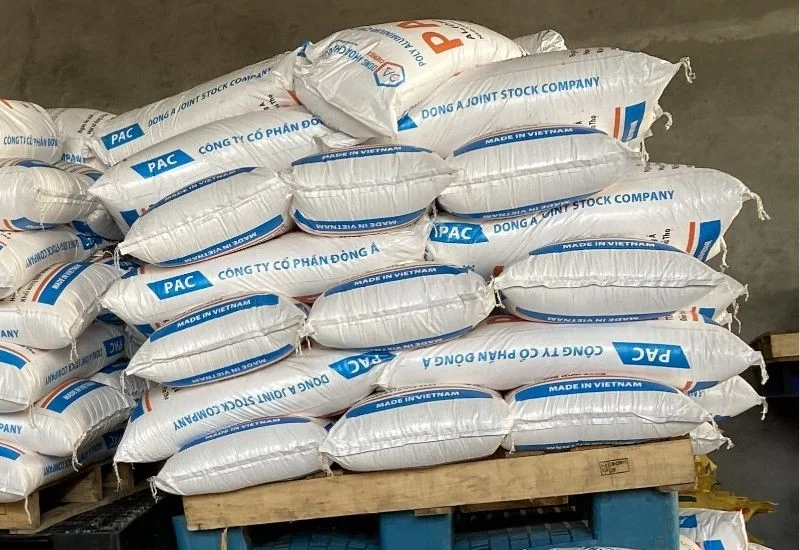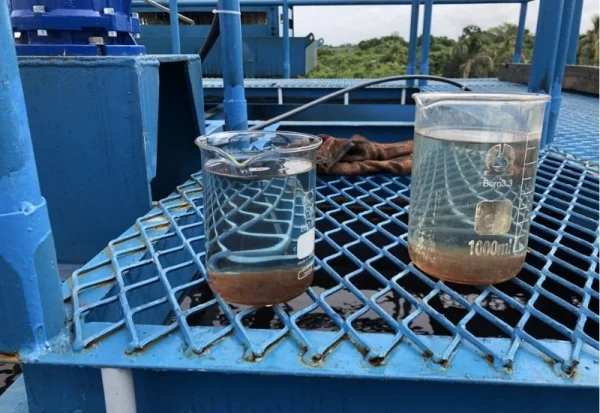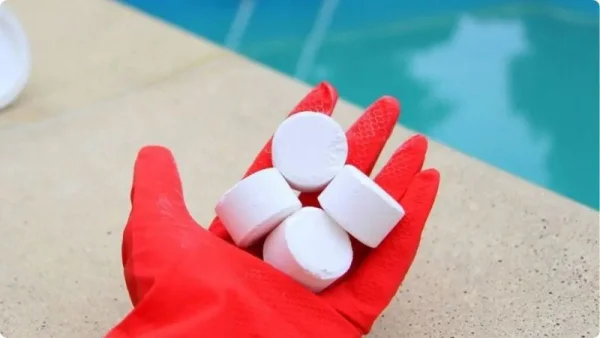
If you work in the water treatment industry, you've likely heard of PAC chemicals. As known, this is a safe chemical to use in water treatment with high effectiveness. However, the question arises: is it safe to touch this chemical directly with your bare hands? In this comprehensive article, we'll explore the answer and provide you with all the essential information you need to know about PAC chemicals and how to handle them safely.
What is PAC?
PAC chemicals, or poly aluminium chloride, is a widely used water treatment chemical with the molecular formula [Al2(OH)nCl6-n]m. It is a coagulant employed in the treatment of drinking water, wastewater, and aquaculture water. PAC helps to coagulate and settle suspended compounds, removing organic substances, bacteria, and viruses from the water.
PAC contains an aluminum content of 28-32%, providing effective coagulation of impurities in water without harming the environment. Currently, PAC is produced in large quantities and widely used in Asian countries, completely replacing aluminum sulfate due to its superior performance and safety profile.

Information about PAC chemicals
Is PAC Toxic?
Compared to other coagulant chemicals, PAC chemicals is considered highly safe. Scientific studies have proven that using PAC in the correct dosage and process is entirely NON-TOXIC. Treating water with PAC will not disrupt the pH balance, ensuring safety for users. PAC is effective even at low concentrations, thus limiting potential health and environmental hazards.
However, if PAC is overused or used improperly, exposure to large amounts of the chemical can cause some adverse effects, such as:
- Difficulty breathing, shortness of breath, sore throat
- Swollen, red eyes
- Skin irritation causing itching, burning, rashes
- Digestive system poisoning: vomiting, stomach pain, diarrhea
Precautions When Using PAC
To ensure safety and effectiveness when using PAC chemicals, note the following precautions:
- Wear Protective Equipment: Equip yourself with necessary protective gear such as masks, gloves, and goggles. Avoid direct contact, inhalation, or ingestion of the PAC chemicals.
- Proper Storage: Store the chemical in a dry, cool place, out of children's reach, and follow the manufacturer's instructions for safe storage.
- Use Appropriate Dosage: Use a reasonable dosage depending on the water condition. Avoid overusing the chemical, which can negate its effects and compromise safety.
- Read Instructions Carefully: Read the instructions carefully before use and avoid using the chemical in inappropriate environments or applications.
- Allow Sufficient Contact Time: Do not use water treated with PAC until at least 4 hours after treatment to ensure complete coagulation and settling of impurities.
- Dispose of Properly: Dispose of any unused or expired PAC chemicals according to local regulations for hazardous waste disposal.
- Seek Medical Attention: If you experience any adverse reactions or symptoms after exposure to PAC, seek medical attention immediately.

Wear protective equipment when using PAC chemicals
Distinct Properties of PAC
PAC coagulant exists in both liquid and powder forms, and their color and chemical mechanisms differ:
Powder PAC
Powder PAC, also known as solid or granular PAC chemicals, has the following distinct properties:
- It has a lemon-yellow or off-white color, resembling a fine powder or granular substance.
- Powder PAC dissolves completely in water, making it easy to prepare solutions for water treatment applications.
- One of the key advantages of powder PAC is its ability to be stored long-term under normal conditions. It does not require special storage conditions or temperature control, making it convenient for transportation and storage in various environments.
- Powder PAC can be more prone to dust formation during handling, which requires proper ventilation and the use of personal protective equipment (PPE) such as respirators or dust masks.

PAC powder is typically supplied in 25kg bags
Liquid PAC
Liquid PAC, also known as solution PAC, exhibits the following distinct properties:
- It has a brownish-yellow color, resembling a concentrated liquid solution.
- Composition: Liquid PAC is a solution of PAC in water, typically with a higher concentration of the active ingredient compared to powder PAC solutions.
- Storage: Liquid PAC chemicals is usually stored in plastic bottles, drums, or cans to ensure longer preservation and prevent leakage or contamination.
- Handling: Liquid PAC is generally easier to handle and dispense compared to powder PAC, as it eliminates the need for dissolution and minimizes dust formation. However, proper PPE, such as chemical-resistant gloves and eye protection, is still necessary when handling liquid PAC.
Notable Applications
Poly aluminium chloride (PAC) is widely used as an industrial coagulant and in various industrial sectors. PAC chemicals is significant in treating turbid, dirty water, producing high-quality water for production and daily use. Therefore, PAC coagulant is applied in the following technological processes:
Wastewater Treatment
PAC treats wastewater containing suspended solids, such as from the dyeing, ceramics, brick, paper, seafood processing, and metallurgy industries. It effectively removes contaminants and clarifies the water, making it suitable for discharge or reuse.
Water Treatment
PAC coagulates suspended impurities for treating domestic and industrial water supply, suitable for water supply plants, swimming pool water stations, etc. It ensures that the treated water meets quality standards for human consumption and recreational use.
Household Water Filtration
PAC chemicals is used for filtering drinking water and domestic water, making it clear from river, lake, and canal water sources. This application is particularly useful in areas where clean water is scarce or contaminated.
Aquaculture Water Treatment
PAC is used in fish and shrimp farming ponds to maintain water quality and promote healthy growth of aquatic species.
Depending on the suspended solids content and the nature of different wastewater types, we use varying dosages of PAC coagulant. The PAC chemical dosage should be determined through direct testing with the target water to be treated, ensuring optimal performance and cost-effectiveness.
Conclusion
If used in the correct dosage and following proper safety precautions, PAC is a non-toxic chemical. However, it can cause skin and respiratory irritation, as well as other adverse effects if overexposed or mishandled. Therefore, it is strongly recommended not to touch this chemical directly with your bare hands.
Always wear appropriate personal protective equipment (PPE) when handling PAC chemicals, and follow all safety guidelines and instructions provided by the manufacturer or regulatory authorities. By taking the necessary precautions, you can enjoy the benefits of PAC in water treatment while minimizing potential health and environmental risks.
Remember, safety should always be the top priority when working with chemicals like PAC. Proper training, handling, and disposal practices are crucial for ensuring the well-being of workers, consumers, and the environment.
Related Articles
How to Prepare PAC for Water Treatment?
Water is essential for life, yet access to clean and safe water remains a significant challenge ...
How Many Chlorine Tablets for Your Pool? A Step-by-Step Guide to Proper Dosage and Maintenance
One of the most crucial components in keeping your pool water crystal clear and free from harmful ...
Finding the Best Chlorine for Your Pool: A Comprehensive Guide
Chlorine is the backbone of pool sanitation, responsible for killing harmful bacteria, viruses, and ...
Liquid Chlorine vs Tablets - Which is Better?
Maintaining a clean and safe swimming pool is crucial for an enjoyable and healthy swimming ...
PAC Powder: The Versatile Solution for Water Treatment
PAC powder , short for Poly Aluminium Chloride powder, has emerged as a game-changer in the field of ...
Safeguarding Your Family's Health with Chlorine Tablets for Drinking Water
Disinfecting water is crucial to eliminate harmful pathogens and ensure safe consumption. Among the ...






